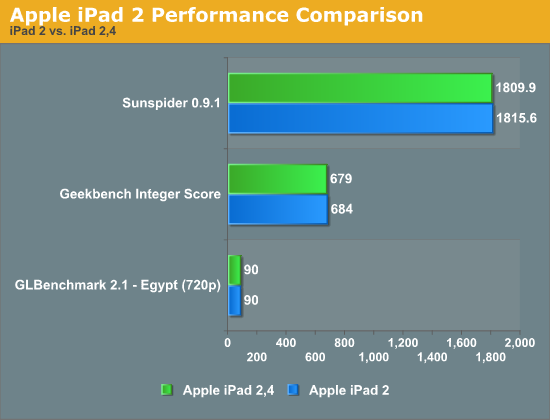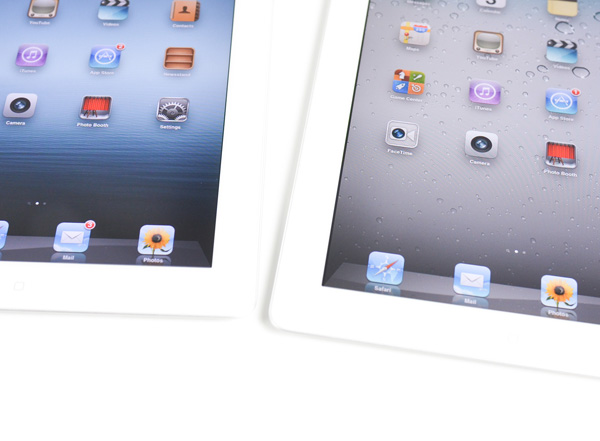The iPad 2,4 Review: 32nm Brings Better Battery Life
by Anand Lal Shimpi on May 4, 2012 12:50 AM ESTDecreased Power Consumption
We obviously know the impact of the new SoC on battery life but here's a look at just how much less power the new platform draws in various conditions. Note that for whatever reason the iPad's power consumption when sitting at the home screen is actually higher than when running our 720p High Profile video playback test. The results were consistent as I tested multiple times across multiple iPads. I have a few thoughts as to what could be happening here:
| Tablet Power Consumption (including Display) | ||||||
| iPad 2,4 | iPad 2 | iPad (3rd generation) | ||||
| Homescreen | 2.7 W | 2.9 W | 6.1 W | |||
| Sunspider | 3.4 W | 4.3 W | 7.6 W | |||
| Moonbat (20 x 4) | 3.9 W | 5.0 W | 8.3 W | |||
| GLBench Egypt (native res) | 3.8 W | 4.5 W | 9.6 W | |||
| GLBench Egypt (offscreen 720p) | 4.1 W | 4.8 W | 10.0 W | |||
| Infinity Blade 2 | 4.3 W | 5.1 W | 10.3 W | |||
| Riptide GP | 3.9 W | 4.7 W | 10.2 W | |||
| Video Playback (720p HP) | 2.2 W | 2.4 W | 4.9 W | |||
Under heavy CPU load (multithreaded Sunspider) we see a 28% increase in power consumption from the 45nm iPad 2,1 compared to the newer 2,4. Keep in mind that we're looking at peak power consumption here, which helps explain the smaller gap on the GPU side than what we saw in our battery life tests. What this data does show however is that the power efficiency improvements can be just as significant for CPU bound workloads, it's simply harder to find workloads that are CPU bound for long periods of time.
Looking at the 3rd generation iPad data reminds us of just how power hungry that platform is. It truly is Apple's performance halo, and it's the perfect target for a 32nm SoC in the future.
The iPad 2 battery life comparison numbers were generated on a lightly used iPad 2 with fewer than 20 charge cycles. While it's possible that some of the differences highlighted on the previous page are due to differences in the batteries between these two devices, it's likely that the variance is in the single digit range at best due to the limited number of charge cycles on the iPad 2 (Update: we confirmed the delta between our iPad 2 results and a brand new, out of box 45nm iPad 2 was < 3%). The power consumption numbers above remove the battery from the equation and help to validate these numbers.
Slightly Improved Thermals
I ran the same temperature test I did for our iPad review: measure maximum surface temperature of the tablet after a 1 hour loop of Infinity Blade 2. The results aren't surprising:
| Thermal Comparison (Max Temperature) | ||||||
| iPad 2,4 | iPad 2 | iPad (3rd generation) | ||||
| Infinity Blade 2 (1 hour) | 33.2˚C | 34.2˚C | 41.9˚C | |||
The iPad 2,4 manages to shave off a degree of surface temperature. It's not really noticeable, but it's there.
Performance
There's no performance difference between the iPad 2,4 and the older iPad 2 models. Regardless of whether you're looking at CPU or GPU performance, the new and older iPad 2s are indistinguishable. Apple definitely embraced the console mentality with this launch.

One difference you will notice between iPads however is variance in the panel vendor and resulting performance. Similar to what we've reported on in the Mac space, Apple likes to get 2 - 3 vendors for most components with very few exceptions (e.g. the CPU/GPU/SoC). We've seen this primarily be an issue with displays and storage devices in Macs, but on the iPad/iPhone side of the fence it can definitely be noticeable as the display plays such a major role in the experience with these devices.
The iPad 2,4 I'm reviewing has noticeably different display characteristics compared to my older iPad 2. My 2,4 sample has a higher maximum brightness (and black level), better grayscale color accuracy, and lower color temperature (more yellow). The new panel isn't any worse than what we've reviewed previously, in fact it's actually slightly better in a number of areas, although some users may be put off by the lower white point temperature (6200K vs. 6600K).
The panel I ended up with here isn't specific to the 2,4, but rather something you could end up with in any iPad 2 model. This is nothing new, but it's always interesting to get an idea of the amount of variance Apple considers acceptable. The new iPad still appears to be in the single or dual source stage (there's conflicting information about whether or not LG made panels are also available today). Sharp is expected to come online in the near future as another source. It remains to be seen how those panels will fare compared to the excellent Samsung panel that Apple launched with however.











100 Comments
View All Comments
Anand Lal Shimpi - Saturday, May 5, 2012 - link
An update - I didn't feel settled with my response to you so I ran a sanity check against a brand new (never before discharged) 45nm iPad 2 and measured a 2.2% difference between the results (fairly normal for run to run variation) and our iPad 2,1 numbers here.Take care,
Anand
Oxford Guy - Friday, May 4, 2012 - link
"There's no known way to tell whether you're getting an iPad 2,4 vs. the older iPad 2,1 without opening the box. The 2,4 unit I ended up with was made in China, ruling out manufacturing region as a way of telling. The external box looks identical, as does the device itself.To deal with that fact, Apple is continuing to ship the original 45nm iPad 2,1 alongside the new 32nm iPad 2,4. Any hiccups in Samsung's production of the A5 and there are still more than enough iPad 2,1s to go around. The risk of moving to 32nm is effectively mitigated, while the learnings Apple gains from building the 32nm A5 will pay off later this year as Apple ramps up production of a 32nm SoC for use in the next iPhone. It's a very smart strategy, one you would expect from an experienced chip company - not a device vendor."
Sorry, but I call this bad business. It's simply bad business for one customer to get something better than another, due to luck. It's business for people to not know what it is they're getting for their money.
Oxford Guy - Friday, May 4, 2012 - link
Correction: "It's bad business for people to not know what it is they're getting for their money."pixelstuff - Friday, May 4, 2012 - link
It's only bad business if people get something worse than what they think they are getting.Deelron - Friday, May 4, 2012 - link
They're either getting exactly what they paid for or more, I don't see any problem with that.ThreeDee912 - Saturday, May 5, 2012 - link
It's the same thing Microsoft and Sony have been doing with consoles. There are literally dozens of different revisions of the 360 and PS3 with more efficient components in them, with little or no difference in the packaging. It's why Anand referenced gaming consoles in his article.Mrmixor - Sunday, May 13, 2012 - link
Incorrect. Read latest posts! Buy iPad 2,4 at will! Crushes the iPad retina in key areas!Xerazal - Friday, May 4, 2012 - link
Serial number was DMQH98DRDFHW, not sure if that helps.had it exchanged without knowing it was the 32nm model, and now i have the normal ipad 2.. whats weird is that i checked the serial to see when they were both manufactured, and the 32nm ipad 2 was manufactured in March 2012 while the 45nm ipad 2 was manufactured in APRIL 2012. they still make the 45nm one i guess.. either that or this is a 32nm version, but geek bench is showing it as ipad 2 now with A5 processor?
Xerazal - Friday, May 4, 2012 - link
Part numbers are different. at least for black it is. Part number for old ipad is MC769LL/A while new is MC954LL/A. too bad i already exchanged my 32nm ipad out and got the 45nm model as a replacement because of light bleeding on the screen.. T~Tpixelstuff - Friday, May 4, 2012 - link
Is there a weight difference between a 2,1 and a 2,4 tablet? If so then maybe there is a weight difference in the full package.I suppose it is possible there are enough discrepancies in the batteries of an identical iPad model that it could make a weight reading impossible.